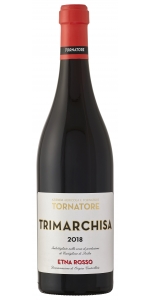Wine from Cantine Tornatore
A long story - of love and passion, of knowledge and respect for places - which has lasted for over a century and a half , since Francesco Tornatore's great-grandfather began farming back in 1865. The Tornatore family has continued, from generation to generation, in the path traced then, developing agricultural activity without ever neglecting the attachment and respect towards the traditions and the territory in which they have their roots.
Located on the fertile northern slopes of Etna, the Tornatore company boasts 100 hectares of lush land, with the largest extension of vineyards in the Etna Doc area , olive groves and hazelnut groves. Representing Sicilian excellence and tradition, our company grows native varieties in historic districts, combining traditional methods and modern technologies to produce superior quality wines. Our passion for wine is reflected in every bottle, celebrating the uniqueness of the Etna area.
Founded in 1865 by Francesco Tornatore's great-grandfather , the company has been carrying on a winemaking tradition that has its roots in the fertile lands of Etna for over 150 years . In 1910, grandfather Giuseppe consolidated the family business by building a millstone in the Piano Fiera district, marking the beginning of an expansion that would encompass other precious lands on the northern side of Etna. Our profound knowledge of the territory , enriched by decades of experience and passed down from generation to generation , allows us today to look to the future with the certainty of those who have always known how to respect the land and its traditions, continuing our commitment to excellence and innovation in the world of wine.
Making wine under the volcano is not easy, yet, for those who succeed, it is the most rewarding thing there is. The Tornatore company is located on the fertile northern side of Etna, whose lands, caressed by significant temperature variations due to the proximity of the Nebrodi Mountains, are home to vines that sink into an unrepeatable terroir , shaped by the activity of the highest volcano in Europe. The magical combination of terroir, climate and production knowledge makes the northern side of Etna an ideal territory for the production of unique wines of exceptional complexity and sensorial richness.
Ruby red with soft purplish reflections. Rich and complex on the nose, very reminiscent of small fruits of brambles, black cherry and a very delicate hint of softwood. On the palate it is decisive, complex and extraordinarily persistent.
Review:
Complex aromas of ripe fruit, toffee, cedar and smoke. Medium body, round and creamy tannins and a fresh, juicy finish.
-James Suckling 94 Points
- back
Selected Options
Wineries
Categories
Pricing
Countries
Regions
Grape Types
Wineries
Organic/Free Shipping
Dark crimson in color, with deep garnet hues. A concentrated array of aromas of mulberry, blackberry and dark plum indicate the richness to come, while savory and complex notes of charcuterie, cedar, sage and five spice tease the senses. Plush and velvety on the palate, the wine has intense fruit concentration with plum, red currant, blackberry and anise flavors, yet an enchantingly elegant and refined structure. Layers of silky tannins reveal the impressive depth of the wine before giving way to an incredibly long finish.
Review:
This has a very complex nose, offering so many facets of spices and fragrance with florals and orange peel, as well as crushed stones, ripe black cherries, blackberries and dark cherries, earth, chocolate and more. The intensity and power here is very tightly held and it has a build of such precise tannins, which carry very intense and assertively ripe blackberries, dark cherries, ripe plums and blueberries. So much on offer here. This has a very bold, intense feel. Exceptional vintage. One of their finest. Try from 2028.
-James Suckling 100 Points
Guillemot-Michel Vire Clesse is made from 100 percent Chardonnay.
Beautifully expressive, with yellow fruits, orange blossom, smoke & flint. Thick and saline on entry, then seriously deep in the mid-palate, with suggestions of exotic fruits perfectly countered by strong minerality. This wine strikes a perfect balance between sweet and salty elements, and it shows vibrant acidity. It boasts a thickness that few other northern Mâconnais can match.
Enjoy with fish (such as sole meuniere), seafood, roasted chicken, goat cheese.





